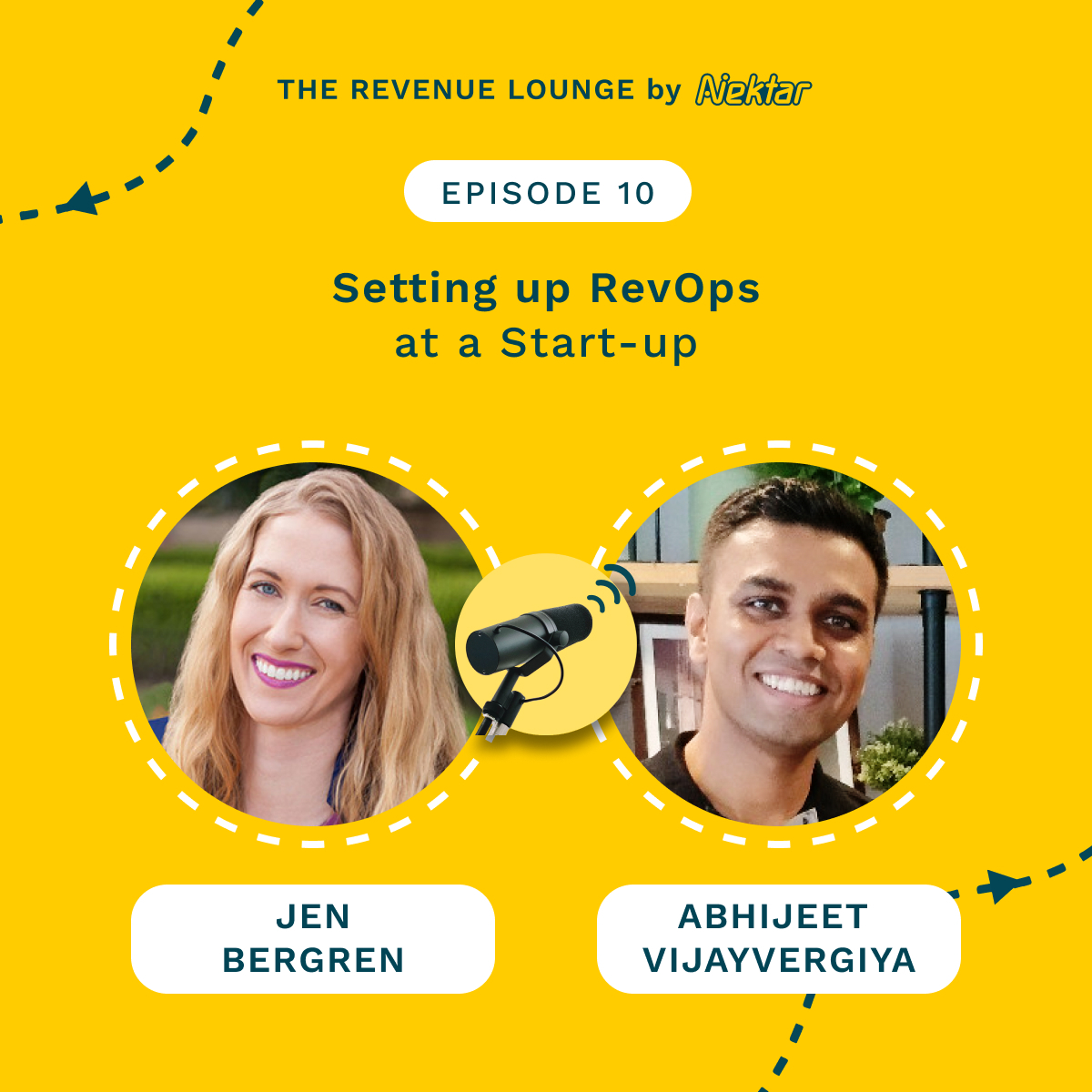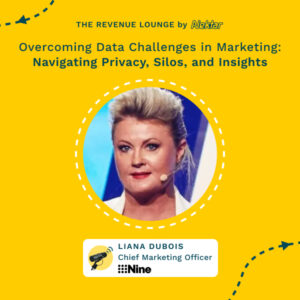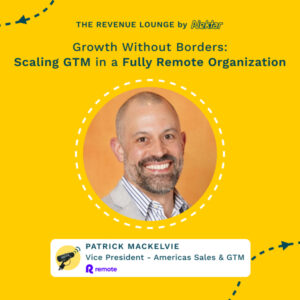Ep #1: Hubspot Customer Retention With RevOps ft. Sid Kumar
April 5, 2023
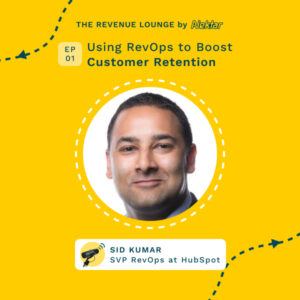
About
The Revenue Lounge
The podcast covers stories from leaders across RevOps, Sales, Customer Success, GTM, Data and Marketing about what drives these functions and what advice they would share with our listeners. With 3 seasons recorded, the podcast currently features 50+ enterprise leaders in the B2B SaaS domain. Tune in to hear from the best in the business
Customer retention has always proved to be an excellent way to boost revenue growth. Acquiring new customers can be expensive and time consuming. There are studies that have found that retaining existing customers can cost 5-10 times less than acquiring new customers.
While new customers are important, in current times when revenue leaders are being asked to “do more with less”, focusing on existing customers can prove as a survival tactic in current times of uncertainty. And RevOps plays a crucial role in driving this retention and reducing customer churn.
Let’s explore more on this topic with our guest today. We are joined by Sid Kumar who is the SVP of RevOps at HubSpot. Sid has been cited among the Top 100 RevOps Leaders of our times. He has more than 2 decades of experience in driving revenue growth and profitability for businesses. He has a passion for building, scaling and leading high velocity go-to-market organizations to accelerate revenue growth.
Let’s hear it from Sid!
Want to learn more about Nektar?
Talk to our team – https://bit.ly/3MishjZ

[00:00:00] Customer retention has always proved to be an excellent way to boost revenue growth. Acquiring new customers can be expensive and time consuming. The studies that have found that retaining existing customers can cost five to 10 times less than acquiring new customers. While new customers are important in current times when revenue leaders are being asked to do more with less, focusing on existing customers can prove as a survival tactic and current times of uncertainty.
[00:00:27] And RevOps plays a crucial role in driving this retention and reducing customer churn. Let’s explore more on this topic with our guest today. We are joined by Sid Kumar, who is the SVP of RevOps at HubSpot. Sid has been cited among the top 100 RevOps leaders of our times. He has more than two decades of experience in driving revenue growth and profitability for businesses.
[00:00:50] He has a passion for building, scaling and leading high velocity go-to-market organizations to accelerate their revenue growth. Hi, Sid. Thank you so much for joining us. How are you doing today?
[00:01:01] I’m doing great. Thanks so much for having me on the show. Excited to chat with you Abhijeet.
[00:01:05] My pleasure. I’m glad we could take time from your busy schedule and schedule this. I’d like to get started. First of all, congratulations on making it to the top hundred leaders of 2022. It’s amazing to see the work you’ve been doing and also your thought leadership for the RevOps community. So it’ll be great if you can we give a brief introduction about yourself to our audience. I’d love to hear a little bit about you, your background, and then we can get started from.
Sure, I’m happy to do that. So right now I lead what we call our flywheel go-to-market strategy and operations teams here at HubSpot. And when we say flywheel, we’re referring to our go-to-market model. Which brings together marketing, sales, and customer success under a consolidated go-to-market organization along with RevOps.
[00:01:47] So we partner very closely with our chief customer officer, our CMO, our chief sales officer and our head of customer success, to really drive an integrated and cohesive engagement model across the customer journey. That’s a current role. And prior to this, I spent about three and a half years at Amazon Web Services and had a number of different roles.
[00:02:08] Most recently there it was leading field sales operations for the Americas, and part of that was responsible for building and launching what we called our cloud sales centre. And that was our global scale go-to-market model, which really connected top of funnel through to revenue. And then part of that, I spent 13 years at a company called CA Technologies.
[00:02:31] Now part of Broad. Across a number of different roles. Everything from, you know, finance strategy ops to leading a customer success organization and then ultimately building and launching a digital sales organization that helped us go down market after the commercial space. So, really passionate about this topic of go to market, and as you mentioned earlier, high velocity go to market.
[00:02:55] And how do you build scalable and repeatable motions that help companies grow So great to be here.
That’s amazing experience and thanks for sharing that with us. I really liked what you said about the GTM flywheel. Especially for B2B SaaS companies, it can unlock significant stakeholder value. So I’d love to understand your definition of what’s a GTM flywheel, if you can elaborate on that for our audience.
[00:03:17] Yeah, that’s a great question. And how I think about it is really connected go-to-market, you know, instead of thinking about a go-to-market model as marketing, sales, and customer success in their silos, how do you think horizontally? How do you really have clarity across your company on a definition of what does your customer journey look like?
[00:03:38] And there may be multiple different flavors of that based on customer segment or geography, but by and large, what does that customer journey look like? How do your prospects like to engage? And that really becomes the underpinning from which you then look at how do you align your organization and how do you think horizontally across that customer journey as opposed to functionally.
[00:04:04] And it’s not to say that there aren’t areas where you need to be really functionally deep. There are things that only marketing is going to really focus on and things that only sales is going to focus on. But really understanding what are those intersection points. That bind those organizations together in the context of solving for the customer, I think is where the magic happens on this.
[00:04:26] There’s a lot of talk about revenue operations in general and this show here is all about revenue operations. I’d love to know your definition of RevOps. How do you define it?
Yeah, I think if RevOps as the go to market COO. I specifically say go to market, because it’s not just about marketing, it’s not just about sales or not just about customer.
[00:04:48] It goes back to that theme around connection and how do you bring these teams together, align them around the common mission, which is serving your customers, your prospects, your partners. And in that context, if you do that well then revenue growth and new customer acquisition becomes an outcome of that.
[00:05:07] So I think of it as connected, go-to-market COO in this context of a connected go-to-market model. But I also think of it as the people, the process, the mechanisms, the data, the systems, and really the operating system that can drive scaled growth. And I think there’s a difference between, What ops has traditionally been, you know, viewed as in, in many cases was traditionally more back office and, and being almost like the sidekick to sales or to marketing or to CS.
[00:05:43] But now this is really like how do you become a joint business partner? How do you help your business partners see around corners. And balanced strategy in addition to helping the business run with excellence and with operating rigor.
That’s one of the most elaborate definition of rev ops. I heard.[00:06:00] Thanks for sharing that. It’s very interesting to hear perspective from someone who’s running RevOps at such a big scale. I’m quite curious to understand, you’ve got a significant history with RevOps. You’ve been doing this for many years now. What was that initial point of entry into Rev Ops?
I believe you got in, the term also did not even exist, right? So just tell us about an interesting story you had in the early days when you got into this.
Yeah, it’s a great question. I wouldn’t say it was a very direct or linear route to RevOps and to your point, it’s really interesting. I mean, RevOps, probably the term, I don’t think I’d heard of it five years ago.
[00:06:35] And apparently it’s been the fastest growing role in the past five years in the US according to what I saw on LinkedIn a couple of months ago. I got here from, you know, my role when I was at CA Technology. It was a 4 billion enterprise software company, heavy on-premise and moving into cloud and SaaS in the back part of its existence as a standalone company.
[00:07:01] And when we were diversifying the product portfolio, what we realized is we didn’t have a go-to-market model that would help drive scale velocity, do it in a cost effective and efficient. To go after mid-market SMB in a very sort of disciplined way, and that’s where I had the opportunity to go build a digital sales organization from scratch.
[00:07:26] Something I hadn’t done before, but had a, a finance strategy and operations background before that, but really got to understand the nuts and bolts of a connected go to market for the first. And really think about that connection between top of funnel. How do you think about the connection between marketing, between sales, customer success and bringing all that together?
[00:07:51] And prior to that, I’d mentioned, I, I built and ran a customer success org. So this was, I, I had the opportunity to go touch and [00:08:00] directly build a number of different components of what today we would call rev op, but really on the other side as. Practitioner of running those teams as a sales leader, marketing leader, customer success leader.
[00:08:13] It was after that point. I just really, what I found was I really enjoyed bringing all that together. You have a finance and ops background and it was bringing that mindset to go to market. And at that point I really realized I really enjoyed that side of the role. You know, I could, I, I liked both sides, but I said, let me be very close to go to market.
[00:08:38] But on the, on the rev ops side of it, so after I, I left that role joined AWS and it was in my first rev ops role. You know, an official rev op sense, and I don’t even think it was called rev ops at that time, but it was the, the terminology was starting to come out, but it was really around [00:09:00] strategy and operations and how do you bring those together as a go-to-market coo.
[00:09:05] That’s when I really started thinking about it that way, was when I got to AWS. Obviously very different scale, very different, you know, customer base and profile. But it was taking some of those learnings from having done it at ca as a practitioner and really thinking about how do you go build a scalable go-to-market strategy model that gives you the flexibility and agility for a, a very large.
[00:09:32] Uh, and, and growing enterprise. So that was how I got into it. And then continue on that journey here at HubSpot in a slightly different context and really focused on the SMB space. Nice. Fascinating. So great to see that you’ve been practitioner yourself, you’ve done all these various roles, and then got all of this together and then now living that.
[00:09:50] A rev stream that they all are seeing unfold in front of us. That’s amazing. I’m quite curious to understand how a company like HubSpot, which is amazing at its [00:10:00] own go-to market, does rev ops, we can just maybe throw some light around. How big is your team or what’s the structure like to operate at that scale for a rev ops automation?
[00:10:08] Yeah, no, it’s a great question. I really think of rev ops as those being those core pillars I talked about earlier. There’s an underpinning of data. And a strong foundation of how you think about data across the customer lifecycle, and then broader integration, obviously with product and with the rest of the organization.
[00:10:30] That really is the bedrock. Then I think about, you know, what is your systems, your automation and tech stack strategy to run the business efficiently, internally, and also think about rep productivity. And, uh, customer experience. How are you optimizing your systems of technology for, uh, a scaled go to market model?
[00:10:52] You really think about those as the foundational, some underpinnings there. And then on top of that, it’s what are the processes and mechanisms [00:11:00] that really bring this connected go to market? Model to life. How do you bring marketing, sales, customer success together? How do you drive that alignment with product, with finance, with people, operations, et cetera?
[00:11:15] Ultimately in the context of, again, working backwards from that customer journey. So a lot around the mechanisms and cadences that rev ops can drive with clear success metrics to help the organization stay focus. And then on top of that really is people and talent, which is really where all this comes together.
[00:11:36] It’s what does your organization need to look like? What’s a talent you need in this organization? How does that differ from the talent from, you know, five to, to 10 years ago when it was sales ops, from marketing ops and that pivot now to rev ops. Right? So those are the some of the core elements that I, I think about.
[00:11:57] The way. Uh, so I lead a [00:12:00] group within the broader rev ops organization that’s focuses on go to market strategy and operations across marketing, sales, customer success. So I have a four, actually I have four pillars as marketing, analytics and insights. That team really works closely with our marketing team across acquisition, across conversion, across revenue, marketing and brand.
[00:12:24] Really think. Leveraging data and insights in a very fine-grained manner to go drive execution in the context of our programs, in the context of how do we continue to drive top of funnel in a systematic way and continue to accelerate the performance area. So that team is really closely tied there with marketing can have a sales strategy and operations team, which includes our go-to-market, uh, COOs in.
[00:12:53] Who then work with our sales operations team to look at what are the horizontal capabilities that we need [00:13:00] to help us drive more scale and efficiency. So there’s the balance of what’s done regionally versus what’s done globally. Where can you get some efficiencies there? And then customer success, strategy and operations.
[00:13:14] We talked a little bit about that earlier. Really, really important role, and especially in this context of customer success renewal. Retention expansion. Really, really critical team there works with our CS success team, support services organizations as well. Those are three functional pillars. But then what I realized and really thought about was there are some horizontal capabilities that are really important to bring together to drive that connected, go-to-market model internally, and drive that and support that.
[00:13:52] And I looked at what were those capabilities that we really wanted to make sure there were no gaps between the functions. And what we [00:14:00] decided on here was bringing together planning. So we brought together planning across the flywheel. So we have one team that does planning for the entire flywheel across marketing, sales, and customer success, and make sure it holds together as part of an operating plan across our demand side, across our, what our reps do.
[00:14:20] The, our customer success teams deliver on the retention, expansion side, incentives and compensation need to make sure that’s aligned with the strategy and with our operating plan across flywheel and then analytics and insights, um, that really cut across flywheel. And it’s not to say that there isn’t deeper analytics going on within each of the functional pillars, but there is a set of what are the core views, what are the KPIs, what are the north stars across that customer?
[00:14:50] That everybody on the flywheel just really needs to understand and, and be really familiar with on what role do they play across the board to help, [00:15:00] uh, help our customers move the needle forward. Does that make sense? It does, it does. It’s a pretty elaborate structure, I must say, but yeah, I mean, that’s what like goes into drive like billions of revenue and efficiency across that GTM flywheel.
[00:15:14] Uh, I’m very curious to understand what’s the ultimate deliverable for a rev ops team In your mind, what should a Rev op org be accountable for? Is it revenue, revenue growth, or productivity per rep, or any other KPIs? That’s a great question. I, you know, I think this mindset on how you think about the role of rev ops is really, really important.
[00:15:34] Do you think about it as, you know, as a go-to-market COO and a business partner, or do you think about it as a support function? Right, and I’ve always thought about this as the go-to-market COO that works hand in hand with our go-to-market leaders. So in that context, I view my objectives and the team’s objectives as delivering on the company’s, you know, financial objectives [00:16:00] and strategic objectives for go-to market.
[00:16:02] So in year it’s, it’s making sure we are in lockstep helping each of these function. Deliver their objectives, their North Star metrics, and then ultimately the company’s overall financial objectives. And then also what are the things we’re doing in year to help pave the path for continued, sustained durable and scaled growth.
[00:16:26] So there’s that strategy element of what do we need to do to continue to think about next year and the year after and really go after the total addressable. In a systematic and scalable and frankly just thoughtful way. Got it. That makes a lot of sense to have that full accountability and aligning towards the broader GTM goals.
[00:16:50] That’s where the biggest impact gets created by the rev op team. So that makes a lot of sense. Let’s move on to the topic of this episode, which is around customer retention. A lot of companies are [00:17:00] bracing, forestation, I don’t think so. The recent. Banking Ks have helped the market in general, so everybody is going to focus a lot more on their existing customers, renewing them, expanding with them, and new pipeline is getting harder and harder to farm.
[00:17:14] So what’s your take on this farming over hunting trend that we are all seeing in? Yeah, I, I don’t tend to look at it as farming versus hunting. I just tend to look at it as you have your existing customers and you have your net new customers, and then how do you think about the go to market motion?
[00:17:32] Differently across both of those, right? So I see where you’re going, but I just, I’ll probably frame it a slightly different way. I, I think about it as if you look at your existing customers, really think about it as a, a couple of phases after your sales team is closing a transaction, working with your marketing team at, in the first phases of the customer journey.
[00:17:53] But a lot of organizations, I think, tend to stop. And every customer success has [00:18:00] become a really big focus, obviously, over the past, I would say 10, 15 years. And it, it’s almost like where rev op is today. I feel like the customer success movement started a number of uh, uh, probably about 10 years ago. And now it’s one of those things you can’t imagine not having.
[00:18:17] Right? And I think it’s all about customer value. And once the customer signs a transaction with a company, it’s. Really understand what were the use cases? What was the reason that they decided to go through a sales cycle with you as an organization, and are you carrying that promise through and helping make sure they get that value and that ROI?
[00:18:42] So I think about it as first is, are you helping them get adopted very quickly? Are you getting them activated? Are you helping them get time to value and up and running in a very short and reasonable period of. After that, that transaction happens. From there, it’s really [00:19:00] looking at and understanding what were the use cases that brought them to you in the first place.
[00:19:05] What if they’re in a particular industry? There may be specific processes, the specific areas that they were hoping to leverage the solution to go help them go faster. In the context of specific functional or company objectives, how are you mapping back to those and helping drive the usage and adoption?
[00:19:25] To go start fulfilling those use cases, you know, after they get activated. So it’s a usage. It’s an adoption. That’s something I think you just need to be very systematic and disciplined about after sale. And that’s like your near term action after, after initial sale. When you think about retention and expansion, that’s just an ongoing motion that is, you’re thinking about your entire install base.
[00:19:52] The renewal is an. If, if a customer is getting value, you’re engaged with your customer throughout [00:20:00] their life cycle with you, the renewal becomes, you know, somewhat of a non-event. If they’re getting value, they’re addressing their use cases and you, you then becomes a, a, a renewal, you know, it’s an event at it’s a point in time and.
[00:20:17] Going back to the, to the growth and expansion, it goes back to if they’re getting value, they’re using their, they’re achieving their initial use cases, you now start to think about, okay, can I expand those use cases either with broaden the existing use case to other users within the department? Can I go to other lines of business and give you an opportunity to go cross sell?
[00:20:41] So I, I think you get acutely focused on. Making sure your customers are achieving the objectives they were seeking to achieve than some of these other, you know, milestones or, you know, points in the journey become just a, a more [00:21:00] natural conversation. Now, it’s not to say that you, you can’t be very systematic about understanding renewals and being very data driven about it.
[00:21:08] I’m not saying that at all. That absolutely, I think you need to be looking. Just like new customer acquisition is a big focus. How do you go think about the balance of renewing your customers on time and looking at opportunities to expand your relationship with them? I think you have to balance both, both those objectives, but I just wanted to share that other earlier in the life cycle perspective that helps with that renewal conversation.
[00:21:33] I think it’s a great answer and I think it all starts from a clear, fast implementation. Great time to value and then nurturing that relationship, right through constant value addition. So the renewal becomes natural, right? And then if you add value to the customer, you’ll expand. Right? Customer grows with you, you grow with the customer, right?
[00:21:50] And I think. HubSpot has been a great company, which has been very focused on adding value to its customers with small companies to large accounts, and we’ve all seen [00:22:00] what has grown that way. So yeah, great to hear your thoughts around it and it completely resonate with the current market conditions as well.
[00:22:07] I’ve heard you speak very passionately about getting the foundation of data right early on, uh, in any organization, and you’ve focused on putting right systems in place to ensure that Rev can run. So what role does data play here when it comes to retaining customers? Can you give some examples of how data has helped you in understanding your customers better and eventually retaining them?
[00:22:28] Yeah, it’s a great question and the short answer is it plays a tremendous role. I think, you know, data will ultimately turn into what are your hindsights, what are your insights? What are your four sites, right? I think of it that way, and understanding the past helps inform the why of the past, and then what are you going do about it in the future?
[00:22:48] So it’s not about data and it’s raw form, but I think you need just a high quality data foundation that you think about earlier in your lifecycle as a company to think about what are the [00:23:00] different touchpoints along that customer journey, whether it’s pre-sale or post-sale, and what are the customer interactions and what are the customer views you want to be able to really understand at a micro.
[00:23:14] And how can that help you as a rev op professional, provide more insights to your stakeholders to help deliver more value to those customers at those different points in the journey? I’ll just give you an example. If it’s around that usage, it’s, it’s really having the telemetry, the fine grained understanding of how a customer is using the solution.
[00:23:38] What are the different features, what are the different capabilities? That they’re using, are they using it to solve the use cases that you had intended? And are there patterns across customers, for example, in a particular vertical or industry like are all manufacturing customers using, or a majority of them [00:24:00] using the, the technology or the system to drive a specific workflow that is very manufacturing specific for.
[00:24:08] Or if you’re in legal, are they using it to drive specific contract and deal approval? Due diligence workflows, just for, for example. And I think it’s an opportunity to, uh, leverage those scaled insights to go back to other customers who may not be aware of those. And it’s an element of how does community play into this?
[00:24:30] How do you drive, you know, shared learnings and help customers uplevel the. Through a community based models. That’s just, that’s just one example. I think also on the, I’ll call it a little bit more on the retention and expansion side. How do you understand your installed base in great detail and what are the signals between first party data, third party data that give you insight into how your [00:25:00] customers are operating and.
[00:25:03] And we’re the right points to have a broader conversation about expansion. Where does it make sense to go have a, a, you know, suite or platform discussion outside of an individual hub discussion in our context? Those are the types of insights we’ll be looking at there. Yeah, very interesting. And I like the fact that you mentioned both first party and third party.
[00:25:24] Because it’s absolutely critical to not just look at the external trends, which the third party data can provide, but also what’s actually going on within your accounts, what your team is doing with your customers. There’s so much of value, like connecting both and then making those targeted calls on. On where to focus on.
[00:25:42] And especially for a large company like yours, there’s so much going around. So where to prioritize, uh, also becomes important. And our data gives a lot of answers if looked correctly. It really helps get an understanding of how data can help with retention. There are also various risks, right? Like John is a killer for most SaaS companies.
[00:25:58] So how can Rev op step [00:26:00] up as a function to mitigate this risk from a customer retention stand? What are some of the top things that come to your mind? Yeah, it’s a great question. I think it, it just, building on my prior answer, I think it’s looking at signals, right? And I think it’s looking at being very proactive in customer engagement a across the life cycle.
[00:26:20] So you’re really in touch with how your customers are thinking. How are they using the solution? Are you close with your, your POCs and executive stakeholders at those. So I think there’s an, there’s certainly like an engagement side of it is, are you close to the pulse of your customer? What’s happening there?
[00:26:39] How’s their business evolving through everything that’s, that’s happening right now in the, in the macro environment? And are you helping them navigate those changes with the solution and bringing. Everything the company and your partners have to bear to, to help them navigate. That’s just the, I think you have to start, um, there.
[00:26:58] And then I think it’s the looking at the [00:27:00] data side. How do you turn that data into the insights and predictive signals? I think that’s where you start to look at the, the different elements of customer behaviour. You start to look at, you know, some signals around. Bringing those together to go look at what are the signals you’re getting from a digital standpoint, from a usage standpoint around how that customer is, is operating and engaging.
[00:27:28] I think you bring the qualitative and the, and some of these quantitative signals together. It gives you a more holistic picture of what that engagement needs to look like. And then I think it really is around how are you going to engage, what does your coverage model look like? And I think there’s all different models.
[00:27:46] I think it really depends on what your go-to-market model is, the type of customer segments you go after. But I think the role of digital engagement and, you know, one to many engagement is, is really important here. And then [00:28:00] thinking about where does a, where does a, a human need to be involved? Where do you leverage AI and, and other skilled engagement models versus where do you need to have a, a human?
[00:28:13] From beginning to end. I think those are the variables that go into that equation, I think are going to differ by company and by type of sale, by type of customer, type of segment you go after. But those are some of the inputs I would think about in terms of really staying proactive and not getting caught off.
[00:28:35] In the context of churn. Does that make sense? Yeah, it does. Just expanding a little bit on that from leading indicators standpoint, right? You mentioned, or signals as you call them, uh, so what are some of the signals or leading indicators or key metrics that come to your mind from, uh, customer retention measurement or just overall customer focus?
[00:28:54] Uh, what are the metrics that you think or nations should track more actively? Yeah, I think our, a really [00:29:00] big one is, is really thinking about how do you tie. Usage to value and the, and the answer to that is going to be very different by solution, by company. If you think about your solution, how can you get indicators from the usage of that solution by your customers that they’re getting value and addressing the use cases that they needed?
[00:29:26] And it could be specific features. It could be specific workflows that they’re activating. It could be, uh, amount of data that they’re ingesting into the platform. A number of messages, like those actual variables are going to be pretty different by customer and by company. But I think it’s really getting clear on what value means to a customer and how do you work backwards from that to get signals and leading indicators to that.
[00:29:57] But I think. [00:30:00] Looking at things like, you know, time to first engagement from the time of sale to when you, you engage from a services or from a partner standpoint to get them onboarded and activated. Those are signals we look at. And then it’s really looking at that usage and adoption journey after to go look at are they getting the value they thought they were going to get in a timely manner?
[00:30:26] And in as frictionless of Matter as possible. When you get into things like retention or expansion, there it becomes more of the, I would call it first party, third party signals around customer behaviors. Your usage is a certainly a big component, but you start to look at things like how often are they engaging with your support organization?
[00:30:50] You’re looking at third party signals. Are they engaging in communities? Are they engaged? With other folks in your network around topics that are [00:31:00] related or ancillary. I think those are some of the signals we’d go look at as well. And you start to think of what could an index in some sense look like That gives you those, those signals.
[00:31:11] You develop a data framework around that and then, Automation plays a big role in helping drive action from those proactive insights. Definitely. And yeah, I think another aspect that could be added there is how, well, I think companies are multi-threading into some of these accounts, right? So multithreading is not just at an opportunity level, but even with an existing customer, right?
[00:31:31] Especially if you have a products or multiple use cases that you offer from a solution standpoint. It’s so much of an opportunity to go very deep into economic nation. Spot on, spot on. I think there’s multi-threading that takes place in a couple of ways. I think one is, as you certainly move up market, I, I think you tend to see more participants in the buying journey, but I also think multi-threading in the context of who needs to be involved in a deal nowadays in this macro environment has [00:32:00] expanded as well.
[00:32:00] The number of checks and balance. Um, and, and getting, getting a cross-functional team, like finance and legal involved earlier on, I think is, is important. But I think it’s just to your point is I think the spirit of your question was you start to move into, you have multiple products that address different lines of business.
[00:32:19] Uh, how do you reference success and value in one line of business across into other lines of business? And then how do you bring it all together, you know, if you have a more of a, a, a platform. A sweet model that you go after. It’s a very good point. Yeah. And there’s so much of an opportunity and value there to be extracted as well as delivered Love that conversation I said around customer success.
[00:32:43] So moving back to RevOps now, as a Rev ops leader, what’s the number one challenge you want to solve for this year? Maybe let’s get to top three. I’d love to hear what are you focusing this year on? Yeah, yeah. It’s a very good question. I think I would say the number one thing is agility. Is, [00:33:00] is thinking about the frameworks, the processes, the capabilities that enable our organization to really stay agile and be able to see signals and be able to go pivot on them.
[00:33:11] So I think if Rev ops is playing a really big role in that, in that context. So we’re doing a lot, uh, lot there. Got it. You’d mentioned that Rev Ops today is what customer success was a decade ago. Let’s talk about future. Right? Right. Fast forward next five. Where do you think rev ops is going to be? Where it’s headed from now?
[00:33:31] Yeah. No, that’s a good question. I think it becomes a C-suite role. I, I really do. And I think it because of the, the balance of this becoming such a strategic aspect to go to market, you see the growth in it over the past, um, you know, five plus years, and as we talked about earlier, it’s not, I don’t see any signs of it slowing down even in this market because in this market, You know, there’s companies out there that can, that are continuing to invest in go to [00:34:00] market.
[00:34:00] You know, that’s something that regardless of what the market conditions are, companies invest in, go to market to come out stronger on the other end and be ready. And if you’re going to invest in go to market, you know, you want to get leverage out of that, that investment. And I think companies are more and more realizing the way to do that is investing.
[00:34:19] Alongside with rev ops right there, as the role that is going to partner with those go-to-market leaders, especially as you’re getting from a point of earlier in your, uh, your journey to getting to that inflection point of scale. It, it’s just one of those key capabilities. And when you start to bring multiple functions, you start to have a VP of sales, you start to have a VP of marketing, you have multiple functions in.
[00:34:46] On your executive team, you do need some role that is going to really be objective, step back and solve, make sure you’re solving for the customer, you’re solving for the company, and then you’re bringing these functions together in a way that that does [00:35:00] that. So I think it’s going be a C-suite role that’s, you know, where I think it’s going go and, and I think about it as really being more and more that go-to-market.
[00:35:10] COO that works alongside, you know, chief Revenue Officer, chief Customer Officer. As a key business partner. Yeah, no, I absolutely love it. I, I love that future and I think Rev Ops rightly deserves that seat at strategy table when a lot of organizations do make a mistake of limiting it as a more of an operating role or a support function.
[00:35:31] But it definitely deserve a seat at a strategy table and there’s so much of value or rev op. Function can deliver in terms of unlocking the GTM flywheel you talked about. Well, that’s awesome. I mean, very excited for the future. Rooting for entire DevOps community there. Yeah, so much to look forward to.
[00:35:48] Uh, so let’s move to our next section, which is rapid fire questions. I’d love to know a little bit about you more on a personal level. So our first question for you is, what’s one book that you have read and you loved in [00:36:00] recent past? Ah, it’s a good question. Uh, I would probably say I’m a big Adam Grant fan, so give and take.
[00:36:07] It’s a book I’ve read in the past and it’s just one that I keep coming back to. It’s a great read. I’m a general fan of anything he writes. I’m really into things that challenge my thinking and help me just grow and, and figure out more ways to give back. So that’s a, that would be one I would say. Yeah.
[00:36:24] Interesting. Next one. What’s the favorite part about working in Rev ops? You know, I love the continuous change and the variety and constantly just being on my toes and really thinking, it goes back to that agility point. It’s being able to, Pivot. Being able to respond and be proactive and not knowing what every day brings in some sense, and having that element of surprise.
[00:36:48] So that’s what I enjoy a lot. Yeah, I think one show can bet that there’s never a dull moment in rev ops For sure. No, never a dull moment. And think that’s part of the [00:37:00] excitement and it’s continuing to evolve and take shape every day. So yeah, definitely. What’s the least favorite part about working in Rev?
[00:37:09] Yeah, data’s always a challenge, right? And we can always get better with data. There’s never going to be a perfect answer, but it’s continuing that journey on making data very, very easily accessible, real time at your fingertips, and really democratize it. And that’s, that’s a challenge I think we’ve all struggled with.
[00:37:28] But a, as we get better and better with that, it really starts to unlock and free up the creativity and the strategic. Side of this role is if you can build that scalable foundation and, and, and really get to a point where you’re spending time on the insight foresight versus the hindsight. So I would say that’s the area that just keeps me up and it’s an area that we all, as an industry, I think really need to keep.
[00:37:55] Thinking about how we make better and more efficient. Absolutely. [00:38:00] 100% with you. I mean, very fact that a company like Nectar stands today is on the foundation of data and making it better, especially for the rev ops teams. So I absolutely love that answer. I always one rev ops leader that you personally look up to and why?
[00:38:13] I’ll, on that one, I, I’d have to say Shafique, he was my former leader at Amazon Web Services land. He. Global worldwide commercial sales strategy and operations and just, you know, his ability to balance detail of the business and understand everything that made the business tick with big picture, strategic thinking in a multi-year manner for a large business that was, you know, scaling at a very rapid pace.
[00:38:45] I’ve never seen anything like that. So he’s someone I’m still close to and, and stay in touch with. Really helped me grow as a rev op professional when I got started. So that’s what I would say. Awesome. Great to hear that. We should get Shafiq [00:39:00] on the re lounge as well. Thanks for sharing that. So what’s one advice that you received from someone that stayed with you and you’d like to share with us?
[00:39:07] I would say we, revops is one of those areas that is just continuing to evolve and grow, and I think keeping a learner’s mindset, growth mindset and just being comfortable taking some risk. And, and being okay not knowing the answer or having or seeking perfection before you, you take some calculator risks.
[00:39:29] And I, I think if you’re really looking for how to solve for your customers and solving for your company, you’re, you’re gonna really help the company. You’re gonna stand out in your career and you’re gonna help grow your impact on the organization versus playing it, uh, too. And, and taking more of a backseat role.
[00:39:49] That would be my, my feedback. Yeah. I mean, risk are required an important, and not just in startups, like in every business. That’s very actionable advice. One, the [00:40:00] advice front. What would be one piece of advice you’d like to give to our audience would like to be in your role someday? Yeah, it’s a good one.
[00:40:08] I did take a bit of a different path as I mentioned, but I think getting a variety of experiences and perspective. If you want to bring together, go to market at some point in your career. I think getting that marketing perspective, if you’re in sales or sales ops is, is really, really important. Getting the customer success perspective is extremely important.
[00:40:30] So I think the more of these perspectives you can either directly get or indirectly get through, uh, you know, some type of shadowing program or getting a mentor from one of those different organizations. I think gives you a more well-rounded view of what the customer journey looks like. And the other piece I would say is really understand what the customer journey looks like for your company.
[00:40:55] And then understand what role your specific organization [00:41:00] or remit plays in that customer journey and what is left and right of that. Right. And we think of it as a flywheel, which is. You know, not necessarily linear, but you know, the analogy is like what are the adjacencies to the role that you have?
[00:41:16] What parts of the customer journey that they touch and how can you learn more about those and get a more well-rounded perspective on those, I think is a pretty important one to, to have those different angles. You can look at it from a marketing perspective or a CS perspective in addition to what you might add as a sales per.
[00:41:35] Yeah. Awesome. Love it. That’s a great aspirational path for any new and up and coming Revs practitioner to grow into like an SVP role someday. But yeah, I do see Revs being a great career path, and I completely agree with you. Five years down the line, we’ll see a lot of Chief Revs officers, for lack of better word.
[00:41:53] But yeah, it’s definitely going to be a CSU tour. Sid, it’s been great having you on the show. I absolutely enjoyed the [00:42:00] convers. Like bunch of golden nuggets sprinkle across our conversation. I’m to re-listen it and I’m sure like our audience are going to enjoy it. But thank you again for your time. It was lovely chatting with you today.
[00:42:11] No, likewise. Thanks for having me. Had had a lot of fun having this conversation. Really, really enjoyed it as well and hope you have a great day and thanks to everybody for listening. Yeah, thank you Syd.

Ep #1: Navigating the Downturn with a Hyperfocus on Productivity
Listen Now
Ep #2: How to Win in Times of Uncertainty
Listen Now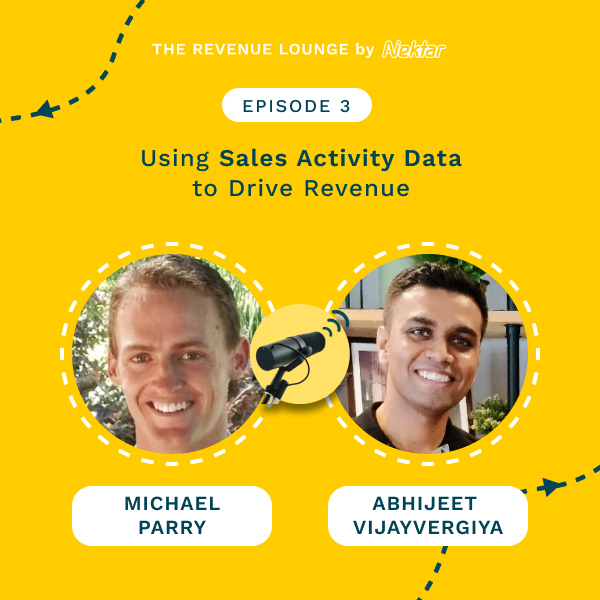
Ep #3: Using Activity Data to Drive Sales Productivity
Listen Now
Ep #4: Creating a Successful RevOps Roadmap
Listen Now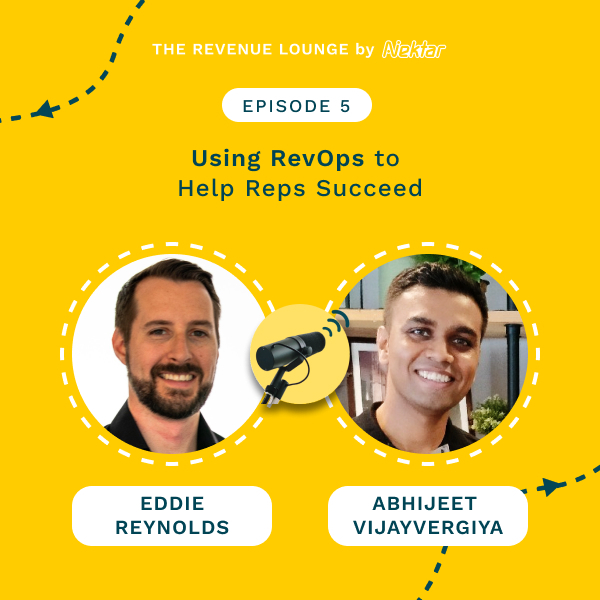
Ep #5: Using RevOps to Help Reps Succeed
Listen Now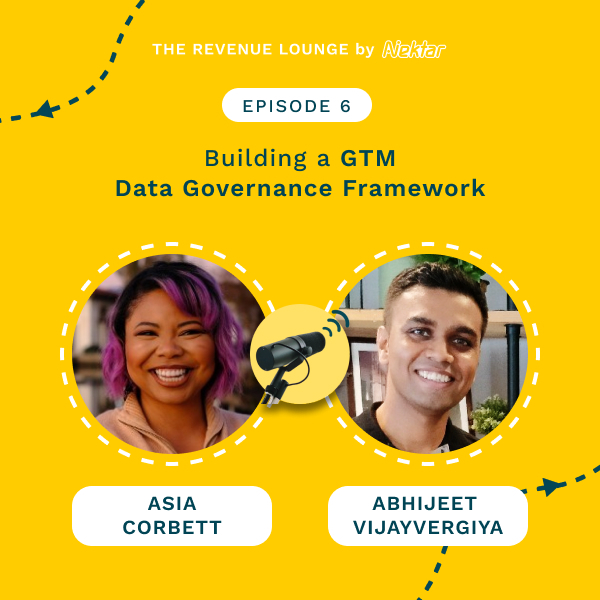
Ep #6: Building a GTM Data Governance Framework
Listen Now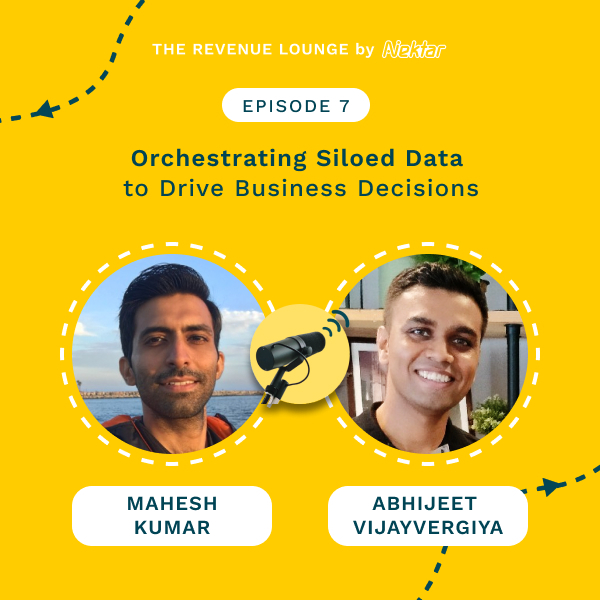
Ep #7: Orchestrating Siloed Data to Drive Business Decisions
Listen Now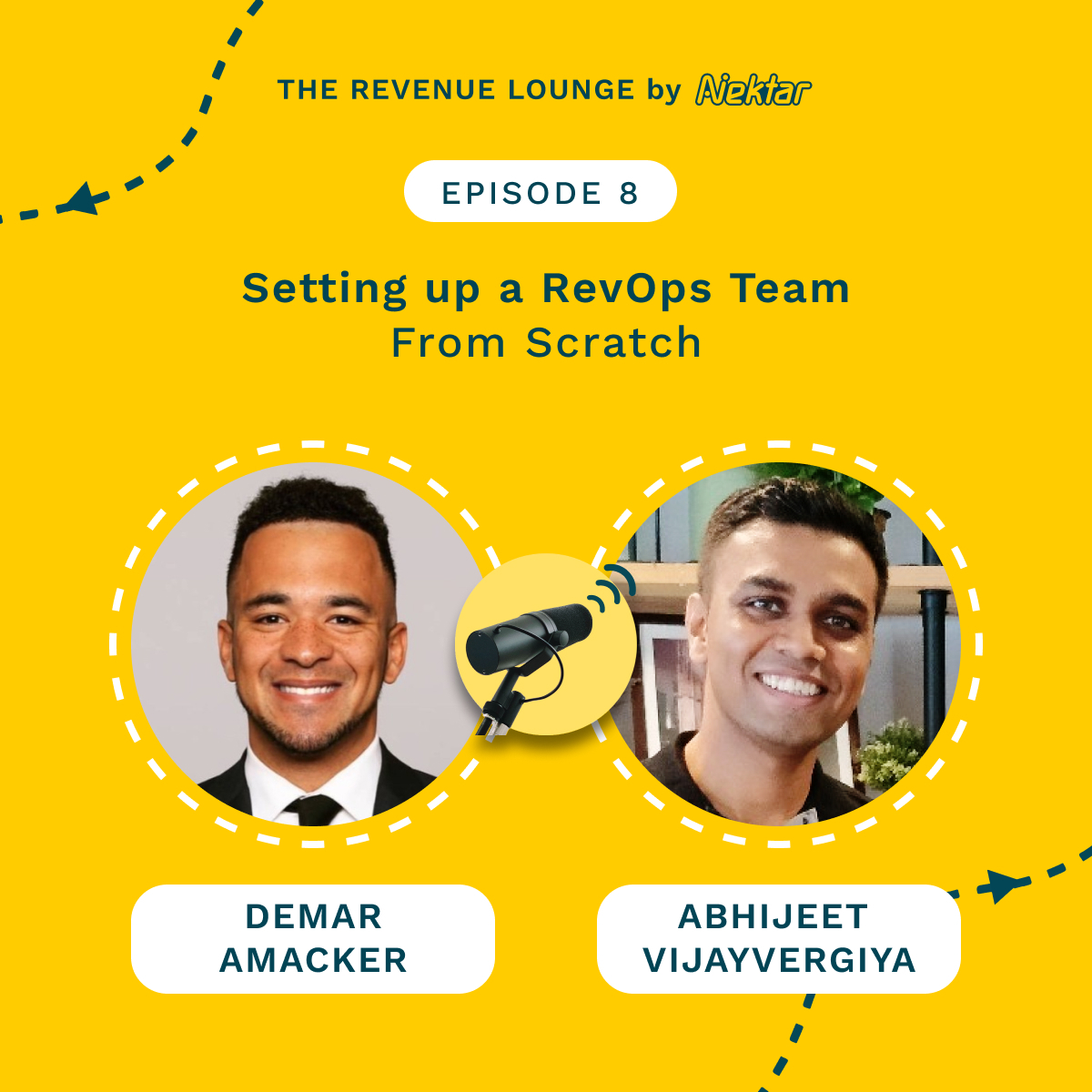
Ep #8: Setting Up a RevOps Team From Scratch
Listen Now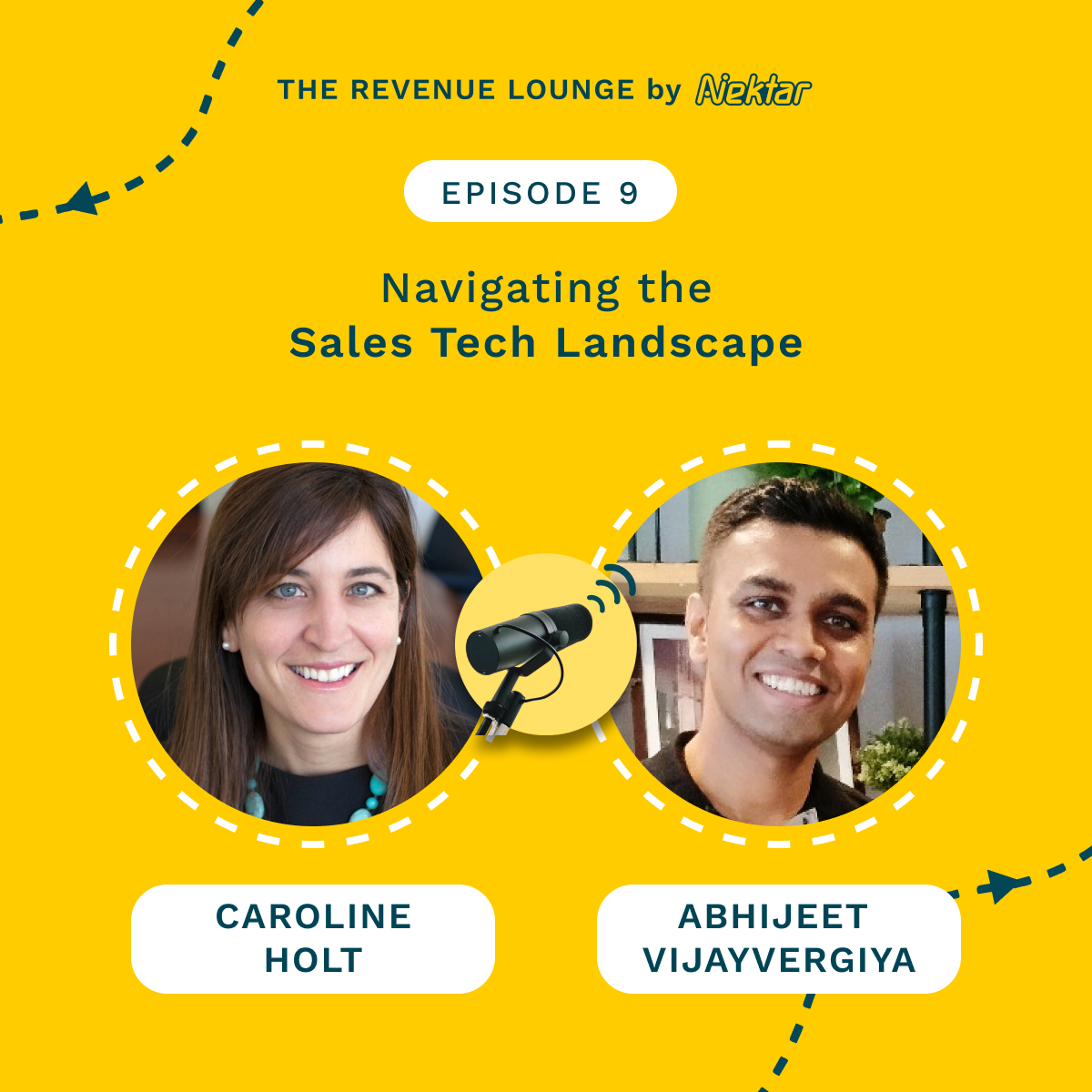
Ep #9: Navigating the Sales Tech Landscape
Listen Now